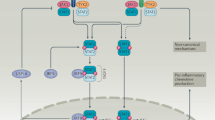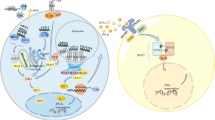Abstract
The last 2 decades have witnessed the discovery and characterization of a new family of cytokines with immunological characteristics similar to those described for type I interferons, type III or lambda interferons. Unraveling the molecular mechanisms underlying each type of interferon has allowed us to understand how some autoimmune diseases can be considered as interferonopathies. Under normal conditions, type III interferons play a key role in the defense against viruses by modulating the functioning of several types of innate and adaptive immune cells. These effects include upregulation of major histocompatibility complex molecules by myeloid dendritic cells, increased functioning of pattern recognition receptors by plasmacytoid dendritic cells, decreased activity of regulatory T cells, enhanced production of antibodies by plasmatic cells and increased expression of chemokines and adhesion molecules by leukocytes and endothelial cells. Notably, all these mechanisms have been described to boost autoimmunity, and type III interferons pathway activation has been related to the pathogenesis of autoimmune conditions such as systemic lupus erythematosus, systemic sclerosis and Sjögren’s syndrome. This review provides an overview of the current evidence on the contribution of type III interferons in the pathogenesis of rheumatic autoimmune diseases in humans.
Similar content being viewed by others
References
Amezcua-Guerra LM, Ferrusquía-Toríz D, Castillo-Martínez D et al (2015) Limited effectiveness for the therapeutic blockade of interferon α in systemic lupus erythematosus: a possible role for type III interferons. Rheumatology 54:203–205
Amezcua-Guerra LM, Márquez-Velasco R, Chávez-Rueda AK et al (2017) Type III interferons in systemic lupus erythematosus: association between Interferon λ3, disease activity, and anti-Ro/SSA antibodies. J Clin Rheumatol 23:368–375
Apostolou E, Kapsogeorgou EK, Konsta OD et al (2016) Expression of type III interferons (IFNλs) and their receptor in Sjögren’s syndrome. Clin Exp Immunol 186:304–312
Benham H, Nel HJ, Law SC et al (2015) Citrullinated peptide dendritic cell immunotherapy in HLA risk genotype-positive rheumatoid arthritis patients. Sci Transl Med 7:290ra87
Blazek K, Eames HL, Weiss M et al (2015) IFN-λ resolves inflammation via suppression of neutrophil infiltration and IL-1β production. J Exp Med 212:845–853
Broggi A, Tan Y, Granucci F et al (2017) IFN-λ suppresses intestinal inflammation by non-translational regulation of neutrophil function. Nat Immunol 18:1084–1093
Bullens DM, Decraene A, Dilissen E et al (2008) Type III IFN-lambda mRNA expression in sputum of adult and school-aged asthmatics. Clin Exp Allergy 38:1459–1467
Castillo-Martínez D, Juarez M, Patlán M et al (2017) Type-III interferons and rheumatoid arthritis: correlation between interferon lambda 1 (interleukin 29) and antimutated citrullinated vimentin antibody levels. Autoimmunity 50:82–85
Chang QJ, Lv C, Zhao F et al (2017) Elevated serum levels of interleukin-29 are associated with disease activity in rheumatoid arthritis patients with anti-cyclic citrullinated peptide antibodies. Tohoku J Exp Med 241:89–95
Chen JY, Wang CM, Chen TD et al (2018) Interferon-λ3/4 genetic variants and interferon-λ3 serum levels are biomarkers of lupus nephritis and disease activity in Taiwanese. Arthritis Res Ther 20:193
Chiriac MT, Buchen B, Wandersee A et al (2017) Activation of epithelial signal transducer and activator of transcription 1 by interleukin 28 controls mucosal healing in mice with colitis and is increased in mucosa of patients with inflammatory bowel disease. Gastroenterology 153:123–138
Cohen TS, Prince AS (2013) Bacterial pathogens activate a common inflammatory pathway through IFNλ regulation of PDCD4. PLoS Pathog 9:e1003682
Contoli M, Message SD, Laza-Stanca V et al (2006) Role of deficient type III interferon-lambda production in asthma exacerbations. Nat Med 12:1023–1026
Dantas AT, Gonçalves SM, Pereira MC et al (2015) Interferons and systemic sclerosis: correlation between interferon gamma and interferon-lambda 1 (IL-29). Autoimmunity 48:429–433
Dellgren C, Gad HH, Hamming OJ et al (2009) Human interferon-lambda3 is a potent member of the type III interferon family. Genes Immun 10:125–131
Dolff S, Witzke O, Wilde B (2019) Th17 cells in renal inflammation and autoimmunity. Autoimmun Rev 18:129–136
Gottenberg JE, Cagnard N, Lucchesi C et al (2006) Activation of IFN pathways and plasmacytoid dendritic cell recruitment in target organs of primary Sjögren’s syndrome. Proc Natl Acad Sci USA 103:2770–2775
Ha YJ, Choi YS, Kang EH et al (2018) Increased expression of interferon-λ in minor salivary glands of patients with primary Sjögren’s syndrome and its synergic effect with interferon-α on salivary gland epithelial cells. Clin Exp Rheumatol 36(Suppl 112):S31–S40
Haasnoot AM, Kuiper JJ, Hiddingh S et al (2016) Ocular fluid analysis in children reveals interleukin-29/interferon-λ1 as a biomarker for juvenile idiopathic arthritis-associated uveitis. Arthritis Rheumatol 68:1769–1779
Hwang JW, Lee KJ, Choi IH et al (2019) Decreased expression of type I (IFN-β) and III interferon (IFN-λ) and IFN-stimulated genes in chronic rhinosinusitis with and without nasal polyps. J Allergy Clin Immunol pii S0091–6749(19):31096-6
Iversen MB, Ank N, Melchjorsen J et al (2010) Expression of type III interferon (IFN) in the vaginal mucosa is mediated primarily by dendritic cells and displays stronger dependence on NF-kappaB than type I IFNs. J Virol 84:4579–4586
Jewell NA, Cline T, Mertz SE et al (2010) Lambda interferon is the predominant interferon induced by influenza A virus infection in vivo. J Virol 84:11515–11522
Jordan WJ, Eskdale J, Boniotto M et al (2007) Modulation of the human cytokine response by interferon lambda-1 (IFN-lambda1/IL-29). Genes Immun 8:13–20
Kotenko SV, Gallagher G, Baurin VV et al (2003) IFN-lambdas mediate antiviral protection through a distinct class II cytokine receptor complex. Nat Immunol 4:69–77
Lasfar A, Lewis-Antes A, Smirnov SV et al (2006) Characterization of the mouse IFN-lambda ligand-receptor system: IFN-lambdas exhibit antitumor activity against B16 melanoma. Cancer Res 66:4468–4477
Lazear HM, Nice TJ, Diamond MS (2015a) Interferon-λ: immune functions at barrier surfaces and beyond. Immunity 43:15–28
Lazear HM, Daniels BP, Pinto AK et al (2015b) Interferon-λ restricts West Nile virus neuroinvasion by tightening the blood-brain barrier. Sci Transl Med 7:284ra59
Lazear HM, Schoggins JW, Diamond MS (2019) Shared and distinct functions of type I and type III interferons. Immunity 50:907–923
Li B, Xie C, Lin X et al (2014) Interleukin-28A promotes IFN-γ production by peripheral blood mononuclear cells from patients with Behçet’s disease. Cell Immunol 290:116–119
Lin SC, Kuo CC, Tsao JT et al (2012) Profiling the expression of interleukin (IL)-28 and IL-28 receptor α in systemic lupus erythematosus patients. Eur J Clin Invest 42:61–69
Luo S, Wang Y, Zhao M et al (2016) The important roles of type I interferon and interferon-inducible genes in systemic lupus erythematosus. Int Immunopharmacol 40:542–549
Mahlakõiv P, Hernandez K, Gronke A et al (2015) Leukocyte-derived IFN-α/β and epithelial IFN-λ constitute a compartmentalized mucosal defense system that restricts enteric virus infections. PLoS Pathog 11:e1004782
Marcello T, Grakoui A, Barba-Spaeth G et al (2006) Interferons alpha and lambda inhibit hepatitis C virus replication with distinct signal transduction and gene regulation kinetics. Gastroenterology 131:1887–1898
Mora T, Masso Rojas FA, Paez A et al (2015) A potential role of type III interferon in the glandular involvement of Sjögren’s syndrome. Arthritis Rheumatol 67(suppl 10):1374–1375
Nocturne G, Mariette X (2013) Advances in understanding the pathogenesis of primary Sjögren’s syndrome. Nat Rev Rheumatol 9:544–556
Obermoser G, Pascual V (2010) The interferon-α signature of systemic lupus erythematosus. Lupus 19:1012–1019
Oke V, Brauner S, Larsson A et al (2017) IFN-λ1 with Th17 axis cytokines and IFN-α define different subsets in systemic lupus erythematosus (SLE). Arthritis Res Ther 19:139
Prokunina-Olsson L, Muchmore B, Tang W et al (2013) A variant upstream of IFNL3 (IL28B) creating a new interferon gene IFNL4 is associated with impaired clearance of hepatitis C virus. Nat Genet 45:164–171
Reyes-Castillo Z, Palafox-Sánchez CA, Parra-Rojas I et al (2015) Comparative analysis of autoantibodies targeting peptidylarginine deiminase type 4, mutated citrullinated vimentin and cyclic citrullinated peptides in rheumatoid arthritis: associations with cytokine profiles, clinical and genetic features. Clin Exp Immunol 182:119–131
Sabat R (2010) IL-10 family of cytokines. Cytokine Growth Factor Rev 21:315–324
Sheppard P, Kindsvogel W, Xu W et al (2003) IL-28, IL-29 and their class II cytokine receptor IL-28R. Nat Immunol 4:63–68
Sixtos-Alonso MS, Avalos-Martinez R, Sandoval-Salas R et al (2015) A genetic variant in the interleukin 28B gene as a major predictor for sustained virologic response in chronic hepatitis C virus infection. Arch Med Res 46:448–453
Srinivas S, Dai J, Eskdale J et al (2008) Interferon-lambda1 (interleukin-29) preferentially down-regulates interleukin-13 over other T helper type 2 cytokine responses in vitro. Immunology 125:492–502
Thomas E, Gonzalez VD, Li Q et al (2012) HCV infection induces a unique hepatic innate immune response associated with robust production of type III interferons. Gastroenterology 142:978–988
Vlachiotis S, Andreakos E (2019) Lambda interferons in immunity and autoimmunity. J Autoimmun 104:102319
Wang F, Xu L, Feng X et al (2012) Interleukin-29 modulates proinflammatory cytokine production in synovial inflammation of rheumatoid arthritis. Arthritis Res Ther 14:R228
Wells AI, Coyne CB (2018) Type III interferons in antiviral defenses at barrier surfaces. Trends Immunol 39:848–858
Witte K, Gruetz G, Volk HD et al (2009) Despite IFN-lambda receptor expression, blood immune cells, but not keratinocytes or melanocytes, have an impaired response to type III interferons: implications for therapeutic applications of these cytokines. Genes Immun 10:702–714
Wolk K, Witte K, Witte E et al (2013) IL-29 is produced by T(H)17 cells and mediates the cutaneous antiviral competence in psoriasis. Sci Transl Med 5:204ra129
Wu Q, Yang Q, Lourenco E et al (2011) Interferon-lambda1 induces peripheral blood mononuclear cell-derived chemokines secretion in patients with systemic lupus erythematosus: its correlation with disease activity. Arthritis Res Ther 13:R88
Wu Q, Yang Q, Sun H et al (2013) Serum IFN-λ1 is abnormally elevated in rheumatoid arthritis patients. Autoimmunity 46:40–43
Xu L, Feng X, Tan W et al (2013) IL-29 enhances Toll-like receptor-mediated IL-6 and IL-8 production by the synovial fibroblasts from rheumatoid arthritis patients. Arthritis Res Ther 15:R170
Yang L, Wei J, He S (2010) Integrative genomic analyses on interferon-ls and their roles in cancer prediction. Int J Mol Med 25:299–304
Zahn S, Rehkämper C, Kümmerer BM et al (2011) Evidence for a pathophysiological role of keratinocyte-derived type III interferon (IFNλ) in cutaneous lupus erythematosus. J Invest Dermatol 131:133–140
Zhang X, Brann TW, Zhou M et al (2011) Cutting edge: Ku70 is a novel cytosolic DNA sensor that induces type III rather than type I IFN. J Immunol 186:4541–4545
Zickert A, Oke V, Parodis I et al (2016) Interferon (IFN)-λ is a potential mediator in lupus nephritis. Lupus Sci Med 3:e000170
Author information
Authors and Affiliations
Corresponding author
Ethics declarations
Conflict of interest
The authors declare that they have no conflict of interest.
Additional information
Publisher's Note
Springer Nature remains neutral with regard to jurisdictional claims in published maps and institutional affiliations.
About this article
Cite this article
Mora-Arias, T., Amezcua-Guerra, L.M. Type III Interferons (Lambda Interferons) in Rheumatic Autoimmune Diseases. Arch. Immunol. Ther. Exp. 68, 1 (2020). https://doi.org/10.1007/s00005-019-00564-3
Received:
Accepted:
Published:
DOI: https://doi.org/10.1007/s00005-019-00564-3




